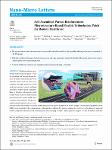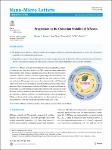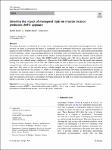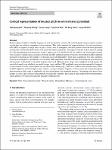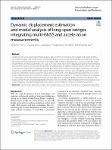Search
Author
- Amir, Ebrahimi (2)
- Aydin, Azizi (2)
- George, Haller (2)
- James, M. Fiore (2)
- next >
Subject
- robotics (9)
- Engineering (8)
- engineering (8)
- công nghệ (3)
- next >
Date issued
- 2020 - 2023 (215)
- 2010 - 2019 (28)
- 2001 - 2009 (6)
Has File(s)
- true (249)
Search Results
In the process of the decarbonization of energy production, the use of photovoltaic systems (PVS) is an increasing trend. In order to optimize the power generation, the fault detection and identification in PVS is significant. The purpose of this work is the study and implementation of such an algorithm, for the detection as many as faults arising on the DC side of a photovoltaic system. A machine learning technique was chosen. The dataset used to train the algorithm was based on a year’s worth of irradiance and temperature data, as well as data from the PV cell used. The method uses logistic regression with cross validation as a new approach to detect and identify faults in PVS. |
Realizing real-time monitoring of physiological signals is vital for preventing and treating chronic diseases in elderly individuals. However, wearable sensors with low power consumption and high sensitivity to both weak physiological signals and large mechanical stimuli remain challenges. Here, a flexible triboelectric patch (FTEP) based on porous-reinforcement microstructures for remote health monitoring has been reported. The porous-reinforcement microstructure is constructed by the self-assembly of silicone rubber adhering to the porous framework of the PU sponge. The mechanical properties of the FTEP can be regulated by the concentrations of silicone rubber dilution. |
Ionic thermoelectrics (i-TE) possesses great potential in powering distributed electronics because it can generate thermopower up to tens of millivolts per Kelvin. However, as ions cannot enter external circuit, the utilization of i-TE is currently based on capacitive charge/discharge, which results in discontinuous working mode and low energy density. Here, we introduce an ion–electron thermoelectric synergistic (IETS) effect by utilizing an ion–electron conductor. Electrons/holes can drift under the electric field generated by thermodiffusion of ions, thus converting the ionic current into electrical current that can pass through the external circuit. |
Physics-based cardiovascular models are only recently being considered for disease diagnosis or prognosis in clinical settings. These models depend on parameters representing the physical and physiological properties of the modeled system. Personalizing these parameters may give insight into the specific state of the individual and etiology of disease. We applied a relatively fast model optimization scheme based on common local optimization methods to two model formulations of the left ventricle and systemic circulation. One closed-loop model and one open-loop model were applied. Intermittently collected hemodynamic data from an exercise motivation study were used to personalize these models for data from 25 participants. The hemodynamic data were collected for each participant at t... |
MXenes are under the spotlight due to their versatile physicochemical characteristics. Since their discovery in 2011, significant advancements have been achieved in their synthesis and application sectors. However, the spontaneous oxidation of MXenes, which is critical to its processing and product lifespan, has gotten less attention due to its chemical complexity and poorly understood oxidation mechanism. This perspective focuses on the oxidation stability of MXenes and addresses the most recent advancements in understanding and the possible countermeasures to limit the spontaneous oxidation of MXenes |
Investment decisions are influenced by various factors, including personal characteristics and managerial issues. In this research, we aimed to investigate the impact of managerial traits on investment decisions by using adaptive neuro-fuzzy inference system (ANFIS) to develop a personalized investment recommendation system. We collected data from potential investors through a survey, which included questions on investment-types, investment habits, and managerial traits. The survey data were used to create an ANFIS model, which is a hybrid model that combines the strengths of both artificial neural networks and fuzzy logic systems. The ANFIS model was trained using 1542 survey data pairs, and the model's performance was evaluated using a validation set. The results of the ANFIS mode... |
Neural coding of auditory stimulus frequency is well-documented; however, the cortical signals and perceptual correlates of pitch have not yet been comprehensively investigated. This study examined the temporal patterns of event-related potentials (ERP) in response to single tones of pitch chroma, with an assumption that these patterns would be more prominent in musically-trained individuals than in non-musically-trained individuals. Participants with and without musical training (N = 20) were presented with seven notes on the C major scale (C4, D4, E4, F4, G4, A4, and B4), and whole-brain activities were recorded. A linear regression analysis between the ERP amplitude and the seven notes showed that the ERP amplitude increased or decreased as the frequency of the pitch increased. |
A Machine and Deep Learning (MLDL) methodology is developed and applied to give a high fidelity, fast surrogate for 2D resistive MagnetoHydroDynamic (MHD) simulations of Magnetic Liner Inertial Fusion (MagLIF) implosions. The resistive MHD code GORGON is used to generate an ensemble of implosions with different liner aspect ratios, initial gas preheat temperatures (that is, different adiabats), and different liner perturbations. The liner density and magnetic field as functions of x, y, and z were generated. The Mallat Scattering Transformation (MST) is taken of the logarithm of both fields and a Principal Components Analysis (PCA) is done on the logarithm of the MST of both fields. The fields are projected onto the PCA vectors and a small number of these PCA vector components are k... |
The solvation structure of Li+ in chemical prelithiation reagent plays a key role in improving the low initial Coulombic efficiency (ICE) and poor cycle performance of silicon-based materials. Nevertheless, the chemical prelithiation agent is difficult to dope active Li+ in silicon-based anodes because of their low working voltage and sluggish Li+ diffusion rate. By selecting the lithium–arene complex reagent with 4-methylbiphenyl as an anion ligand and 2-methyltetrahydrofuran as a solvent, the as-prepared micro-sized SiO/C anode can achieve an ICE of nearly 100%. Interestingly, the best prelithium efficiency does not correspond to the lowest redox half-potential (E1/2), and the prelithiation efficiency is determined by the specific influencing factors (E1/2, Li+ concentration, deso... |
Compared with acceleration-based modal analysis, displacement can provide a more reliable and robust identification result for output-only modal analysis of long-span bridges. However, the estimated displacements from acceleration records are frequently unavailable due to unrealistic drifts. Aiming at obtaining more accurate and stable results for determining the modal parameters, this study develops a multi-rate weighted data fusion approach for estimating displacement responses in dynamic monitoring of structures based on global navigation satellite system (GNSS) and acceleration measurements. |


